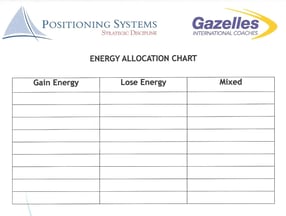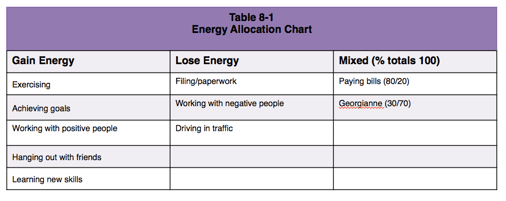 Where does all your time go?
Where does all your time go?
Are you able to invest your time on high-value activities or are you spending your time on low-value activities?
How well do you sustain your energy each day? Do you find yourself energized and active all day, or do you find that you frequently run out of energy and become exhausted as you run through your day?
ENERGY ALLOCATION CHART
Smart Tribes author Christine Comaford shares An Energy Management Tool to help get you focused on your high energy activities. I’ve completed the chart myself and it helped identify the activities I gain energy from, what activities I lose energy doing, along with a number of activities that get mixed results from. Mixed means sometimes they help you gain energy, and sometimes they drain you and you lose energy. The key in the Mixed column is to identify the context or specific part of the interaction that’s draining.
As an example: Someone you manage may enliven you most of the time. However this subordinate frequently interrupts you when you are trying to focus, thus draining your energy. Ask yourself this question: Is he fifty-fifty in the Mixed column? What percentage would you assign?
Can you identify the context or specific part of the interaction that’s draining?
What do you do with your list once you’ve completed it?
Get focused and present. Understand what’s really happening.
What is your energy allocation?
How many Gain items did you have versus Lose and Mixed?
Here’s an important question: How are you contributing to the energy loss you are experiencing? Are you giving unclear expectations (practicing clarity and explicit communication)? Are you creating unrealistic or non-agreed-upon deadlines (Comaford has another tool to help here called the Accountability Equation)? Are you paying attention to both your Map and theirs?
ACTION PLAN
Let’s see what you can do to make improvements in how you manage your energy.
- Step one: Identify activities that help you gain energy.
- Step two: Identify those activities that drain your energy.
- Step three: Identify activities that are mixed. What are the activities, or people that sometimes give you energy and at other times drain energy?
Can you get rid of anything in your Lose column? Are there any activities you can delegate that drain you?
Here’s a question you may not have considered. What if it’s a person, does he/she have to be in your life?
If someone is pulling you away from your priority or ONE THING, consider putting a fence around people or establish boundaries for them and for you. Comaford suggests; in the case of relatives, you may have to strategize (with your significant other or siblings) about how to reduce the points of stress.
In the book Comaford shares how one of her customers negotiated with his spouse to manage his in-laws differently at the annual family function they hosted so that everyone shared the load and he didn’t feel like a servant.
MIXED CATEGORY
The Mixed category is the trickiest. A good strategy is to move the items from the Mixed list firmly into the Gain list. Look at Christine Comaford’s example in the chart shown here. Comaford has someone else pay her bills and in doing so she moved Georgianne out of her life. Comaford suggests conducting this energy management audit is something she encourages SmartTribes to do regularly. It’s a great way to engage all the SmartTribe Accelerators in one practice.
in the chart shown here. Comaford has someone else pay her bills and in doing so she moved Georgianne out of her life. Comaford suggests conducting this energy management audit is something she encourages SmartTribes to do regularly. It’s a great way to engage all the SmartTribe Accelerators in one practice.
I would encourage you to pick up Comaford’s book SmartTribes. We’re going to explore the next piece of this chapter in my next blog, however every chapter in her book is loaded with ideas that are practical and more importantly actionable.
TAKEAWAYS
- What percentage of your energy is spent on high-value activities?
- What did you learn from your Energy Allocation Chart?
Act
- Here’s an exercise that will help streamline where your time is spent:
- Write down your top three business priorities.
- Check your calendar to see if each appointment / time allocation is supporting your top three priorities.
- For each appointment / time allocation, score 1 for yes; 2 for sometimes yes / sometimes no, mixed, or uncertain; 3 for no. How many 2s and 3s do you have? You may need to get more clarity or change the scope of the 2s to get them out of the ambiguous category (or reduce it at least).
- Now work on getting rid of the 3s (ditch, delegate, or defer) and ensuring 70% or more of your time is spent on 1s. Plan out a process for getting 70% of your time allocated to high-value activities. How quickly can you make this shift?
There are three basic default roles that people lean toward: Victim, Rescuer, Persecutor These three roles are interdependent (there must be a Persecutor for there to be a Victim for the Rescuer to save). Which role do you play? (Hint it’s probably the role you played subconsciously or consciously in your family growing up) What is the result of being in this role—what does it “cost” you? What role do you think the key stakeholders in your organization see you in? How do you reinforce this?
We’ll look at these Comaford Ideas and the role the tension triangle plays in your ability to get the right outcomes next blog.






.jpeg?width=150&height=135&name=Hand%20with%20marker%20writing%20the%20question%20Whats%20Next_%20(1).jpeg)

